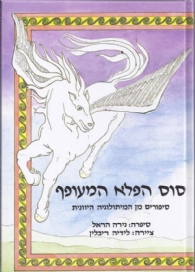Title of the work
Country of the First Edition
Country/countries of popularity
Original Language
First Edition Date
First Edition Details
Nira Harel, Sus haPpele Hameufef: Stories from the Greek Mythology. Masada Publishing, 1983, 94 pp.
Genre
Myths
Short stories
Target Audience
Children (9–12 yo)
Cover

Courtesy of Keter Publishing House c/o Modan Publishing.
Author of the Entry:
Ayelet Peer, Bar-Ilan University, ayelet.peer@gmail.com
Peer-reviewer of the Entry:
Lisa Maurice, Bar-Ilan University, mauril68@gmail.com
Elżbieta Olechowska, University of Warsaw, elzbieta.olechowska@gmail.com

Picture taken from the Author’s website (accessed: July 2, 2018), courtesy of Nira Harel.
Nira Harel
, b. 1936
(Author)
Nira Harel is a prolific Israeli author and editor. She was the editor of children’s journal (“Pilon”) and of children’s books and also wrote more than 50 children’s books. Nira was raised in Tel Aviv and later she worked as a teacher. She was the editor of children’s books and well as an author. She won several rewards for her work.
Sources:
Official website (accessed: July 2, 2018).
Profile at the library.osu.edu (accessed: July 2, 2018).
Profile at the dafdaf.co.il (accessed: July 2, 2018).
Bio prepared by Ayelet Peer, Bar-Ilan University, ayelet.peer@gmail.com

Lidia Rivlin (Illustrator)
Summary
The book offers a selection of stories with pictures which present the rich world of the classical Greek mythology to young Israeli readers, in a clear and simple language. The book opens with a short introduction of Greek mythology. It also contains a glossary for the different characters at the end.
The stories which appear in this book are:
- What is Mythology?
- The Pomegranate Seed
- The Fire Thief
- Midas' Golden Touch
- The King has Donkey Ears
- The Narcissus Flower
- The Amazing Winged Horse
- The Sun's Chariots
- The Amazing Hosts
- The Perfect Statue
- The Daphne Tree
- Profound Love
- The Head of Medusa
- The Labyrinth
- The Most Beautiful Woman in the World
- The Punishment
- The Twelve Labors
- The Enchanting Musician
- Glossary: Whom Did We Meet in the Mythological Stories?
Analysis
In an interview with the author (November 2016)*, she explained her decision to write the book Sus haPele HaMeufef (The Flying Wondrous Horse). She said it was a commitment she made to herself, following a book of Greek mythology stories she read as a teen. That book had a great influence on her since through this book she discovered the world of Greek mythology. When she became an author herself, she decided to adapt the stories anew. Since its initial publication, she says, her book, Sus haPele HaMeufef was printed over and over through the years. Regarding her choice of stories in the book, she said that she picked the ones she herself liked in her youth. She believes that even in our modern world, there is still room for such stories since they represent a cultural heritage that is the foundation of the Western culture and as such, they should be continued to be accessible to the later generations.
She also added that today children see the characters from Greek mythology in movies, TV or theatres so it seems appropriate to her that they should read about them in books first.
According to Maurice (2016), "this work was the author's own initiative, inspired by her childhood love of mythology, which was itself the result of her reading of Jan Parandowski's Mythology. Harel had a completely free hand in selecting and adapting the stories which she used in this book, and made these decisions based on Parandowski's book and her own general knowledge, having no other background in classics or in mythology other than this. Aimed at the nine- to twelve-year-old market, the ninety-four page book, illustrated with pencil drawings, has remained in print ever since." (p. 323) Maurice also adds that: "the emphasis in Nira Harel's volume is far more on the tales of heroes than on those of the gods." (p. 326)**
* A telephone interview between Ayelet Peer and Nira Harel from November 2016.
** Maurice, Lisa, "Greek Mythology in Israeli Children's Literature", in Katarzyna Marciniak, ed., Our Mythical Childhood... The Classics and Literature for Children and Young Adults, Leiden: Brill, 2016.
Further Reading
Lisa Maurice, "Greek Mythology in Israeli Children's Literature", in Katarzyna Marciniak, ed., Our Mythical Childhood... The Classics and Literature for Children and Young Adults, Leiden: Brill, 2016, 307–332.


